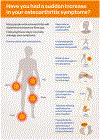Osteoarthritis Flares
- PMID: 35410678
- PMCID: PMC10523485
- DOI: 10.1016/j.cger.2021.11.001
Osteoarthritis Flares
Abstract
The phenomenon of flares is a common feature in the daily life of people with osteoarthritis (OA). Characterized by episodes of sudden-onset increases in signs and symptoms, their impact can often be distressing and disabling. Despite their potential to have both short-term and long-term consequences for patients across the whole course of the condition, their occurrence and optimal management are not fully understood. This article provides a contemporary perspective on defining OA flares and their potential triggers, and offers suggestions for how health professionals might explore flare patterns with patients in clinical practice and frame timely best-practice treatment approaches.
Keywords: Acute; Exacerbation; Flare; Management; Osteoarthritis; Pain; Symptom variability.
Copyright © 2021 Elsevier Inc. All rights reserved.
Figures



References
-
- Hunter DJ, Schofield D, Callander E. The individual and socioeconomic impact of osteoarthritis. Nat Rev Rheumatol 2014;10(7):437–41. - PubMed
-
- Brandt KD, Dieppe P, Radin EL. Etiopathogenesis of osteoarthritis. Rheum Dis Clin North Am 2008;34(3):531–59. - PubMed
-
- Wieczorek M, Rotonda C, Coste J, et al. Trajectory analysis combining pain and physical function in individuals with knee and hip osteoarthritis: results from the French KHOALA cohort. Rheumatology (Oxford) 2020;59(11):3488–98. - PubMed

